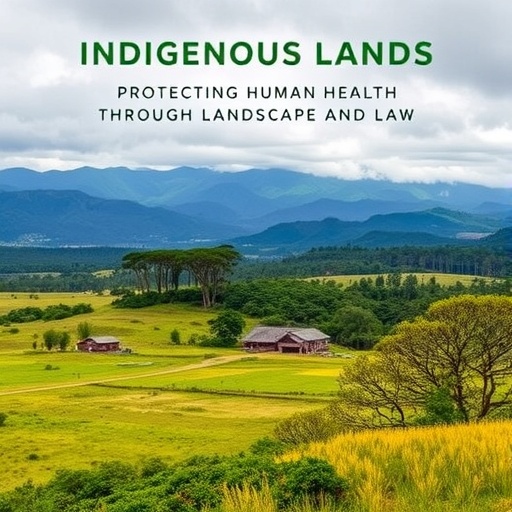Recent research conducted by Barreto et al. has shed light on an essential yet often overlooked aspect of public health: the role of Indigenous territories in safeguarding human wellbeing. The study underscores the intricate relationship between landscape structure, legal status of these territories, and their varying impacts on health outcomes for Indigenous and non-Indigenous populations alike. As the world grapples with unprecedented environmental changes and health challenges, this research emphasizes the pressing need to acknowledge and support Indigenous governance as a key component of global health strategy.
In examining Indigenous territories, the researchers highlight that these regions serve not just as cultural preserves but also as vital ecosystems that support biodiversity, clean water, and sustainable livelihoods. The intricate balance of these natural systems impacts air quality, food security, and social cohesion, all of which are linked to health. A focus on the landscape structure allows a deeper understanding of how the ecological integrity of these areas contributes significantly to the health outcomes of communities residing within and around them.
One of the critical findings from Barreto et al. is that the legal status of Indigenous lands profoundly influences their ability to protect health. Those territories recognized under law often enjoy greater autonomy regarding land use and management, leading to better preservation of the landscape and its resources. This legal recognition not only empowers Indigenous communities but also facilitates sustainable practices that can mitigate the impacts of climate change on health. Conversely, segregated lands often face exploitation and degradation, ultimately threatening the health of their inhabitants.
Landscape structure is not merely a backdrop; it is a dynamic element that shapes human health experiences. The study identifies various landscape features, such as forests, wetlands, and rivers, emphasizing their roles as buffers against environmental stressors. Forested areas, for instance, are not only essential for carbon sequestration but also play a crucial role in maintaining air quality and providing medicinal plants. These ecological attributes directly correlate with lower incidences of respiratory diseases, showcasing the health benefits rooted in ecological conservation.
The interaction between Indigenous populations and their lands reveals a compounding layer of complexity. Indigenous peoples, often culturally and spiritually tied to their territories, engage in sustainable practices honed over generations. Such practices contribute to both biodiversity and resilience against environmental changes, thereby enhancing health outcomes. The study argues that recognizing these traditional ecological knowledge systems is paramount, encouraging a reciprocal relationship between governance frameworks and Indigenous practices that prioritize health and well-being.
As health crises become more prevalent, the study suggests that integrating Indigenous governance into public health policies can yield invaluable benefits. For instance, collaborative management of resources in Indigenous territories can ensure that healthcare approaches are more adaptive and culturally relevant, ultimately improving health metrics. Policymakers, therefore, must understand the significance of local governance structures and the autonomy they provide to Indigenous communities in protecting their health.
The implications of this research extend beyond Indigenous territories and into wider global health dialogues. As countries face health disparities exacerbated by environmental injustices, understanding how Indigenous lands function as health sanctuaries could redefine public health strategies. The necessity for a paradigm shift in policy frameworks to include Indigenous perspectives and legal recognition is more crucial than ever. This would not only fortify health systems but also promote environmental stewardship as a means of public health prevention.
Moreover, this compelling study advocates for multi-sectoral approaches that engage various stakeholders, including Indigenous communities, government entities, and health organizations. Such collaboration can facilitate shared understanding and respect for Indigenous rights while forging pathways to sustainable health outcomes. The often-disparate worlds of environmental science and public health stand to gain from this integrated perspective, which encourages co-management and biocultural strategies.
Additionally, the researchers stress the need for comprehensive data collection on health outcomes in Indigenous territories. A fuller understanding of these health dynamics can better inform resource allocation and intervention strategies tailored to the specific needs of Indigenous populations. By prioritizing research efforts in these areas, health jurisdictions can effectively address the unique challenges faced by these communities, strengthening both health outcomes and ecological sustainability.
In conclusion, Barreto et al. present a persuasive case for recognizing Indigenous territories as critical components in safeguarding human health. The evidence presented in their study holds notable implications for public health policy, emphasizing the interplay between landscape structure, legal frameworks, and health outcomes. This research not only contributes to the academic discourse surrounding Indigenous health but also serves as a rallying call for stakeholders worldwide to embrace Indigenous governance as pivotal for achieving equitable health solutions in an era of environmental crisis.
The potential value of this research cannot be overstated. As increasingly complex health and environmental challenges arise, the role of Indigenous territories must be acknowledged and harnessed. By elevating Indigenous voices and integrating their wisdom into contemporary health planning, society can work towards a health paradigm that honors the past while promoting a sustainable and healthy future for all.
Subject of Research: The role of Indigenous territories in safeguarding human health through landscape structure and legal status.
Article Title: Indigenous Territories can safeguard human health depending on the landscape structure and legal status.
Article References: Barreto, J.R., Palmeirim, A.F., Sangermano, F. et al. Indigenous Territories can safeguard human health depending on the landscape structure and legal status. Commun Earth Environ 6, 719 (2025). https://doi.org/10.1038/s43247-025-02620-7
Image Credits: AI Generated
DOI: 10.1038/s43247-025-02620-7
Keywords: Indigenous territories, human health, landscape structure, legal status, biodiversity, public health policy, environmental justice, Indigenous knowledge, ecological conservation, health outcomes.




